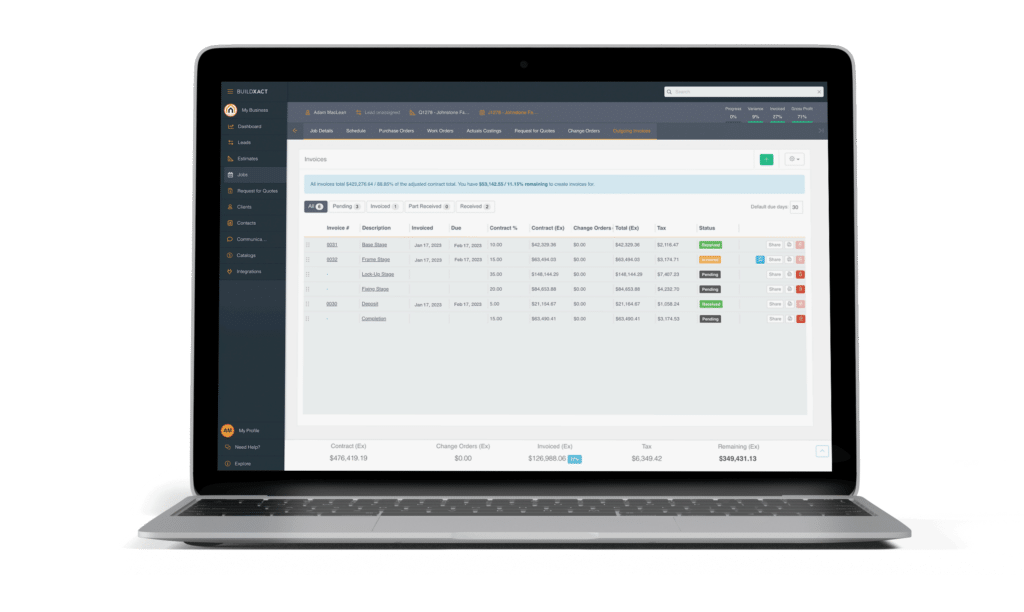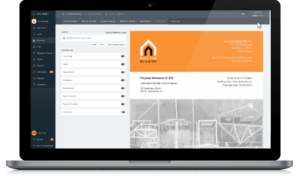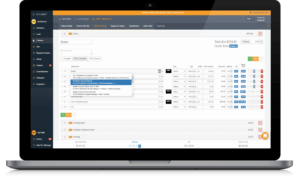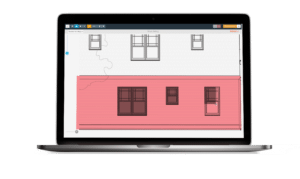Every home-building project presents unique circumstances demanding flexibility in contracts and billing to align with the project’s scope, customer expectations or current market conditions.
Let’s delve into the essentials of setting up contracts and explore how modern construction management software simplifies purchase orders, work orders and customer invoices.
Cost-plus construction: managing expenses and statements
A cost-plus contract ensures that contractors, builders or remodelers get reimbursed for allowable expenses incurred during a home build. This contract involves an additional predetermined amount, or markup (often a percentage of total costs), to cover profit.
It’s invaluable when the scope of work is ambiguous or the project involves high uncertainty.
Elements of a cost-plus contract
Understanding the key components and language of a cost-plus construction contract is crucial:
- Direct Costs – these encompass labor, materials, equipment or subcontractor fees directly associated with the project. Think of it as paying for the individual puzzle pieces that form the whole.
- Indirect Costs/Overhead – these are expenses related to running the business, such as administrative hours, loans, utilities and general office expenses. They support the business as a whole – like paying for the time spent assembling the puzzle or the table used for holding the pieces.
- Profit – after reimbursing project costs, the additional fee, or “plus” calculated as a percentage of total allowable costs, represents profit. This should be viewed as an investment in future business growth. True profit, or net income, comes only when all expenses, depreciation and salaries have been accounted.
Flexibility and reduced risk are the primary advantages cost-plus contracts offer builders or contractors, especially in markets prone to price fluctuations. Unlike fixed-price contracts with predetermined costs, cost-plus contracts reimburse expenses as they occur and offer an agreed-upon fee for profit. With this, you can better focus on quality rather than cost-cutting.
Working mechanism of cost-plus contracts
Cost-plus construction contracts reimburse for project costs, including labor, materials and overhead. Alongside these costs, there’s a predetermined profit margin that, as previously mentioned, is a percentage of total project costs and delivered as markup. Costs and markup should be clearly stated on customer invoices. Invoices should make clear what payments are outstanding and what payments have been made.
However, customers will still need an overall cost estimate. Accurate estimating systems are vital to arrive at a clear total budget or cap that is free of the potential errors that could erode anticipated profits.
Cost-plus vs. fixed-price contracts
Choosing between the two hinges on factors like project complexity, risk assessment and customer expectations. Fixed-price contracts offer cost certainty but require you to manage potential overruns either by covering the costs yourself or sending out change orders.
Cost-plus contracts offer flexibility and peace of mind amid uncertainties but often requires more detailed customer invoicing to explain ongoing costs.
When to use a cost-plus construction contract
A cost-plus construction contract is typically used for jobs or projects with ill-defined project scope or where numerous change orders are anticipated. Often, complex custom homes make changes inevitable. Sometimes, site changes can occur (that greenfield was actually a brownfield, for example).
Many builders employ cost-plus construction contracts to mitigate the risks associated with unforeseen challenges, to build better customer relationships through ongoing collaboration, and to build trust through transparency of costs.
Of course, it depends on the type of project, and analyzing said project will help you weigh your advantages vs. disadvantages.
Utilizing Guaranteed Maximum Price (GMP)
A GMP sets a maximum price for a project, holding the contractor accountable for costs exceeding the threshold. While advantageous, underestimating costs in a GMP can lead to losses.
Other types of Cost-plus construction contracts
Various options exist, such as Cost-Plus-Fixed-Fee, Cost-Plus-Incentive-Fee, Cost-Plus-Percentage-of-Cost and Cost Plus Award Fee (CPAF), each offering distinct advantages and risks.
• Cost-Plus-Fixed-Fee
Here, you’re reimbursed for allowable costs during the project with a fixed fee added if needed.
• Cost-Plus-Incentive-Fee
Reimburse you for costs with an agreed-upon fee; however, if you keep costs below that agreed-upon fee, you may receive a share of the cost savings.
• Cost-Plus-Percentage-of-Cost
While used less today, it still offers flexibility, but many builders avoid it because your fee increases with higher project costs, making a project less cost-efficient.
• Cost Plus Award Fee (CPAF)
It is a slightly riskier contract because it is performance-based. This type of agreement offers the contractor reimbursement for work completed and additional compensation for an outstanding performance of work.
Software’s role in simplifying cost-plus planning
Construction software streamlines cost-plus construction planning by easing estimating, cost tracking, budgeting and communication.
Tools like Buildxact automate many data entry tasks, easing administrative burdens and minimizing errors in invoicing.
Buildxact facilitates job setup, purchase and work order creation, and customer invoicing with detailed breakdowns. This automation reduces data handling, saving time and ensuring accurate, detailed invoices.
How Buildxact can help with cost-plus contracts
When you set up a job in Buildxact, you specify early on whether it’s a cost-plus job or fixed-price. Buildxact includes functions for creating purchase orders and work orders, and these orders are what generates customer invoices.
As you order and receive materials and complete tasks with hired labor, Buildxact captures all the details not only for your own accounting but also to display on customer invoices. As you build customer invoices, you can adjust your cost-plus percentage for individual line items.
Buildxact generates invoices in multiple file formats, like pdf, Word document and Excel. Invoices contain all your payment terms, payment totals and company and customer details. All the information is laid out on a ready-to-use template that can be printed or emailed using your business logo.
In this way, there’s no double-handling of data so you save time while preventing errors. Invoices show as much detail as you wish, depending on your situation with the customer.


















